
Ploceidae is a family of small passerine birds, many of which are called weavers, weaverbirds, weaver finches and bishops. These names come from the nests of intricately woven vegetation created by birds in this family. In most recent classifications, Ploceidae is a clade, which excludes some birds that have historically been placed in the family, such as some of the sparrows, but which includes the monotypic subfamily Amblyospizinae. The family is believed to have originated in the mid-Miocene. All birds of the Ploceidae are native to the Old World, most in Africa south of the Sahara, though a few live in tropical areas of Asia. A few species have been introduced outside their native range.

Antipatharians, also known as black corals or thorn corals, are an order of soft deep-water corals. These corals can be recognized by their jet-black or dark brown chitin skeletons, surrounded by the polyps. Antipatharians are a cosmopolitan order, existing at nearly every location and depth, with the sole exception of brackish waters. However, they are most frequently found on continental slopes under 50 m (164 ft) deep. A black coral reproduces both sexually and asexually throughout its lifetime. Many black corals provide housing, shelter, food, and protection for other animals.
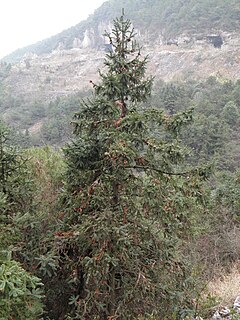
Cunninghamia is a genus of one or two living species of evergreen coniferous trees in the cypress family Cupressaceae. They are native to China, northern Vietnam and Laos, and perhaps also Cambodia. They may reach 50 m (160 ft) in height. In vernacular use, it is most often known as Cunninghamia, but is also sometimes called "China-fir". The genus name Cunninghamia honours Dr. James Cunningham, a British doctor who introduced this species into cultivation in 1702 and botanist Allan Cunningham.

The Asian conical hat, commonly known as an Asian rice hat, or just rice hat, coolie hat, oriental hat, or farmer's hat, is a simple style of conical hat originating in East, South and Southeast Asia specifically from Hue, Viet Nam given they are depicted on terracotta pots dating back over 2,000 years, they have likely been worn in some form for several millennia; and notable in modern-day nations and regions of Bangladesh, Bhutan, China, Cambodia, India, Indonesia, Japan, Korea, Laos, Malaysia, Myanmar, Philippines, parts of Outer Manchuria, Taiwan, Nepal, Tibet, Thailand, and Viet Nam.

A whorl is a single, complete 360° revolution or turn in the spiral growth of a mollusc shell. A spiral configuration of the shell is found in numerous gastropods, but it is also found in shelled cephalopods including Nautilus, Spirula and the large extinct subclass of cephalopods known as the ammonites.

Sea snail is a common name for slow-moving marine gastropod molluscs, usually with visible external shells, such as whelk or abalone. They share the taxonomic class Gastropoda with slugs, which are distinguished from snails primarily by the absence of a visible shell.

The gastropod shell is part of the body of a gastropod or snail, a kind of mollusc. The shell is an exoskeleton, which protects from predators, mechanical damage, and dehydration, but also serves for muscle attachment and calcium storage. Some gastropods appear shell-less (slugs) but may have a remnant within the mantle, or the shell is reduced such that the body cannot be retracted within (semi-slug). Some snails also possess an operculum that seals the opening of the shell, known as the aperture, which provides further protection. The study of mollusc shells is known as conchology. The biological study of gastropods, and other molluscs in general, is malacology. Shell morphology terms vary by species group. An excellent source for terminology of the gastropod shell is "How to Know the Eastern Land Snails" by John B. Burch now freely available at the Hathi Trust Digital Library.
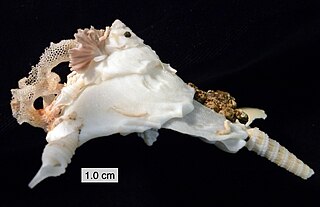
Xenophoridae, commonly called carrier shells, is a family of medium-sized to large sea snails, marine gastropod mollusks in the clade Littorinimorpha.
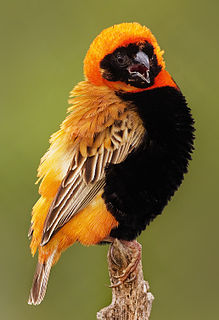
The southern red bishop or red bishop is a small passerine bird belonging to the bishop and widowbird genus Euplectes in the weaver family, the Ploceidae. It is common in wetlands and grassland in Africa south of the Equator. North of the Equator, it is replaced by the northern red bishop or orange bishop which was formerly regarded as a subspecies of this species.

Conica are a cnidarian suborder of the Leptomedusae. They make up the bulk of their order; their internal relationships are not well resolved, and most of the roughly 30 families are not yet assigned to a superfamily.

Plumularioidea is a superfamily of hydrozoans in the order Leptothecata.

Odostomia is the most speciose genus of minute sea snails, pyramidellid gastropod mollusks. This genus is placed in the family Pyramidellidae in the subfamily Odostomiinae. There are several hundred species in this diverse genus

Elasipodida is an order of sea cucumbers. They have numerous appendages, including conical papillae and leaf-like tentacles. Although many species are benthic, a number are pelagic, and may have their appendages modified to form sails or fins. Most members of the order inhabit deep-sea environments, such as the species of the genus Enypniastes.

The blacklip abalone, Haliotis rubra, is an Australian species of large, edible sea snail, a marine gastropod mollusk in the family Haliotidae, the abalones.
Haplosyllis spongicola, the sponge worm, is a species of polychaete worm in the family Syllidae. It was previously classified as Syllis spongicola and is part of a species complex of closely related species that are difficult to distinguish morphologically and where the demarcation between them is unclear. It is found in shallow temperate, subtropical and tropical seas worldwide, wherever its host sponges are found.
Acanothopathes is a genus of coral in the family Aphanipathidae that contains five species. Species in this genus are found in the Caribbean Sea, Indian Ocean, and Pacific Ocean in temperatures ranging from about 10 to 30 degrees celsius at depths from 50 to 400 meters.

Grevillea ramosissima, commonly known as fan grevillea, is a shrub species of the family Proteaceae. It is native to south-eastern Australia.
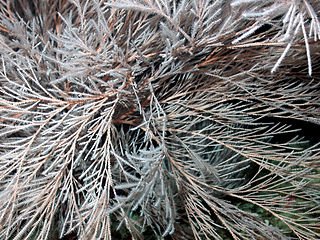
Aphanipathes is a diverse genus of black corals in the family Aphanipathidae, typified by large polypar spines. However, there are some disagreement in the correct taxonomic classification of this genus. The Global Biodiversity Information Facility (GBIF) classifies Aphanipathes as being a genus of the family Aphanipathidae while the Integrated Taxonomic Information System (ITIS) classifies it as a genus of the family Antipathidae.
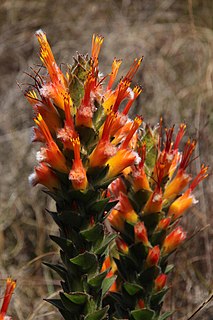
Mimetes capitulatus is an evergreen, upright, rounded shrub of about 2 m (7 ft) high, from the family Proteaceae. It has geyish green, lance- to egg-shaped leaves ending in a thickened tip. The flower heads and subtending leaves form a cylindric inflorescence, topped by ordinary, more or less upright leaves. Each primarily orange flowerhead contains 10–13 flowers with conspicuously scarlet styles, yellow under the narrow hourglass-like pollen presenter at its tip. Flowers can usually be found from mid-June till December, peaking in August. It is called conical pagoda in English and skraalstompie in Afrikaans.

Protea sulphurea, also known as the sulphur sugarbush, is a flowering plant of the genus Protea in the family Proteaceae, which is only known to grow in the wild in the Western Cape province of South Africa. A vernacular name for the plant in the Afrikaans language is heuningkoeksuikerbos or Skaamblom.

















